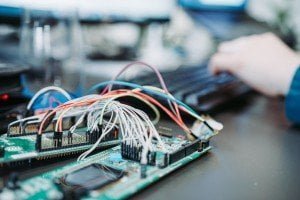Written by Anne Fischer | 1 October 2019
A team of MIT researchers has designed photovoltaic-powered sensors that could potentially transmit data for years before they need to be replaced. One of the uses could be as the Internet of Things (IoT) sensors on devices.
The team mounted thin-film perovskite cells — known for their potential low cost, flexibility, and relative ease of fabrication — as energy-harvesters on inexpensive radio-frequency identification (RFID) tags.
According to an article in MIT News, the cells could power the sensors in both bright sunlight and dimmer indoor conditions. What’s more, the team found the solar power actually gave the sensors a major power boost that enabled greater data-transmission distances and the ability to integrate multiple sensors onto a single RFID tag.
Of late, other researchers have used solar cells as energy sources for IoT sensor devices. But those were essentially “shrunken-down versions of traditional solar cells” — not perovskite. The traditional cells can be efficient, long-lasting, and powerful under certain conditions “but are really infeasible for ubiquitous IoT sensors,”according to one of the MIT researchers Sai Nithin Kantareddy, a PhD student in the MIT Auto-ID Laboratory, as quoted in the report.
On the other hand, traditional solar cells were bulky and expensive to manufacture. They were also inflexible and could be made transparent, which can be useful for temperature-monitoring sensors placed on windows and car windshields.
Perovskite cells, on the other hand, can be printed using easy roll-to-roll manufacturing techniques for a few cents each; made thin, flexible, and transparent; and tuned to harvest energy from any kind of indoor and outdoor lighting.
The idea, then, was combining a low-cost power source with low-cost RFID tags, which are battery-free stickers used to monitor billions of products worldwide. The stickers are equipped with tiny, ultra-high-frequency antennas that each cost around three to five cents to make.
“In the future, there could be billions of sensors all around us. With that scale, you’ll need a lot of batteries that you’ll have to recharge constantly. But what if you could self-power them using the ambient light? You could deploy them and forget them for months or years at a time,” said Sai. “This work is basically building enhanced RFID tags using energy harvesters for a range of applications.”
In a pair of papers published in the journals Advanced Functional Materials and IEEE Sensors, MIT Auto-ID Laboratory and MIT Photovoltaics Research Laboratory researchers describe using the sensors to continuously monitor indoor and outdoor temperatures over several days.
The sensors transmitted data continuously at distances five times greater than traditional RFID tags — with no batteries required. Longer data-transmission ranges mean, among other things, that one reader can be used to collect data from multiple sensors simultaneously.
Joining Kantareddy on the papers are: Department of Mechanical Engineering (MechE) postdoc Ian Matthews, researcher Shijing Sun, chemical engineering student Mariya Layurova, researcher Janak Thapa, researcher Ian Marius Peters, and Georgia Tech Professor Juan-Pablo Correa-Baena, who are all members of the Photovoltaics Research Laboratory; Rahul Bhattacharyya, a researcher in the AutoID Lab; Tonio Buonassisi, a professor in MechE; and Sanjay E. Sarma, the Fred Fort Flowers and Daniel Fort Flowers Professor of Mechanical Engineering.
To read the complete article, click here.


